How could Germany - a nation steeped in Christian culture for so many centuries - breed Nazism and allow millions of innocent neighbors to genocide? Does the responsibility for this also fall on the shoulders of the German clergy?
In this hour of destiny, together with all German Catholics living abroad, I greet with joy the new German Reich, whose philosophy combines Christian and national values - wrote after Hitler came to power, his countryman Bishop Alois Hudal, the respected rector of the Roman seminary of Anima, which educated clergymen from Germany and Austria.
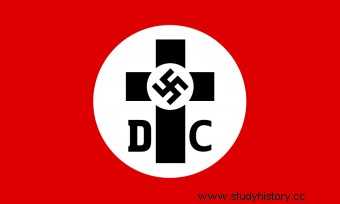
Flag of the organization "German Christians" (German "Deutsche Christen") (source:public domain).
At the time of Hitler's rise to power, Germany had approximately 65 million inhabitants, of which 2/3 Protestants, 1/3 Catholics, and less than 1% other denominations. (including half a million Jews). There were tens of thousands of influential clergymen behind these millions of Christians. Why were they silent as the country slid towards a brutal dictatorship? Even more so - why did some of them cherish the dictator?
In 1939, the news of the victory over Poland in German churches rang the bells. In the same year, Cardinal Adolf Bertram - the metropolitan of Wrocław and chairman of the German Bishops' Conference - sent Hitler birthday greetings on behalf of all German bishops Catholic.
Protestant clergy photographed themselves with Nazi criminals, arms outstretched in Nazi salute. In fact, some church dignitaries supported the Nazis even after the war ...
Better Nazism than Bolshevism?
Nazism initially appeared to be a clerical threat no less and as hostile to Christianity as Bolshevism. But - as Dr. Kevin P. Spicer points out - even at a time when the Church did not yet tolerate the Nazis, of the approximately 24,000 Catholic priests (data from the early 1930s) at least 138 were called "bronze priests" . They publicly praised Hitler, and several dozen joined the NSDAP !
The authorities of the German Church also gradually relaxed their position. Many clerics saw Hitler's seizure of power as the beginning of a national revival which will also revive religious life and put a dam on communism. Many bishops ceased to be bothered by the membership of the NSDAP and the greeting of the Nazi salute.
Counting on the preservation of influence in Germany and a more friendly position of the rulers, the Catholic Church concluded a concordat with the Third Reich. At the same time, some of the clergy were clearly impressed by Hitler's "successes" and the propaganda work of Goebbels. The poison of Nazism had a similar effect on them as it did on millions of ordinary Germans.
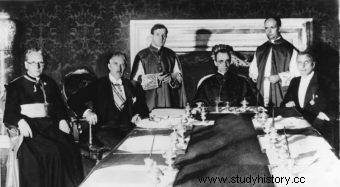
The concordat with the Third Reich was signed on July 20, 1933. In the center, Cardinal Eugenio Pacelli, future Pope Pius XII (source:Bundesarchiv, Bild 183-R24391, license:CC-BY-SA 3.0).
Even those who over time opposed the Nazi rule underwent a period of fascination with Nazism, such as the Archbishop of Freiburg, Conrad Gröber, once known as the "brown bishop" . Propaganda was based on pseudo-religious emotions and naive popular piety, as well as faith in patriarchal values that would guarantee discipline and order - explains Ian Kershaw in the book “To Hell and Back. Europe 1914-1949 ”.
Hitler strengthened his power, and many clergy did not think to defend democratic principles. After Germany had been deprived of its freedom of expression and political parties had been liquidated, only churches could shape the beliefs of society - points out Michael Phayer in his book "The Catholic Church and the Holocaust". That did not happen though. Pragmatism, nationalism and, over time, fear prevailed.

Catholic bishops hailing with Nazi officials:Joseph Goebbels (first from right) and Wilhelm Frick (second from right) (source:public domain).
German clerics were silent for fear of the unpredictable Nazis. Although they were co-authors of the text of Pope Pius XI's encyclical "With Burning Concern" ("Mit brennender Sorge"), directed against Nazi ideology, this 1937 document read in German churches turned out to be the last such spectacular attempt at resistance.
German bishops gave up open confrontation with the Nazi regime, fearing that such actions would negatively affect the position of the Church Kershaw explains in "To Hell and Back." Europe 1914-1949 ". They were afraid of arrests, closing schools and church organizations, and confiscation.
Nordic Jesus
If the bishops were silent, there was little more that the rank and file could do. Meanwhile, theoretically Catholic magazines wrote about Germany's rights to a superpower in the world and to Lebensraum . Nazi theologians were not idle like Ernst Bergmann, who began promoting ideas that were shockingly contrary to Christian doctrine. Here the Old Testament is not part of the Bible, Jesus is not a Jew but a Nordic and Hitler is the Messiah!
The pro-Nazi movement among Protestant churches, the so-called German Christians, won supporters. As early as 1935, out of a total of 18,000 Protestant pastors, a sixth was active there.
Driving the German Christians of Reichsbischof Ludwig Müller enjoyed hailing along with the Nazis . In addition, the National Socialist tops of the Third Reich promoted neo-paganism, referring to the old Germanic religion.
Christianity in the Third Reich found itself in a serious crisis as the Germans left Catholic and Protestant religious associations. For example, a quarter of a million believers left their ranks in 1932, and almost half a million in 1939.
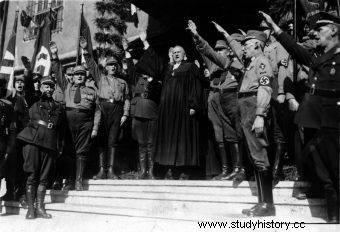
Opening of the National Synod in Wittenberg. In the center Ludwig Müller, Reichsbischof of the Evangelical Church of Germany and member of the Deutsche Christen organization (source:Bundesarchiv, Bild 183-H25547, license:CC-BY-SA 3.0).
Overall, between 1932 and 1944, approximately 650,000 Catholics and 2.1 million Protestants died. And it was not a form of protest against the collaboration of clergy with the Nazis:there was a growing number of non-religionists and neo-pagans favoring power and involved in Nazi ideology.
Silence about the Holocaust
The Catholic field bishop of the Wehrmacht, Franz Justus Rarkowski (born in Olsztyn), did nothing to deal with war crimes. He praised the soldiers and emphasized that they were waging a just war. Photos of German chaplains in hats with a cross under an eagle with a swastika are terrifying and disgusting today.
It is scary to think about what confessions of their soldiers passed on to the agenda ... But the episcopate must have known about genocide as well. In 1942, during a meeting in Fulda, German bishops discussed whether to speak about the persecution of Jews. They decided to abandon heroic actions for small achievements .
Also in 1942, the aforementioned Cardinal Adolf Bertram learned from Margarete Sommer - a Catholic activist from Berlin, dealing with social assistance - about the massacres carried out in the summer and autumn of 1941 in Kaunas. The ecclesiastical dignitary, however, pretended that nothing was happening. And over time, he even consciously began to avoid Sommer. From 1944, he demanded that his shocking reports be confirmed by the Bishop of Berlin, Konrad von Preysing. One of the few prominent clerics openly opposing Nazism.
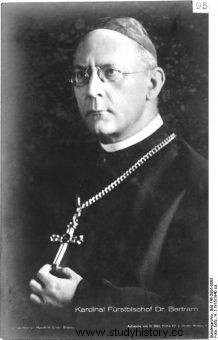
Cardinal Adolf Bertram pretended that he did not know about the pogrom of Jews in Kaunas (portrait photo of Adolf Bertram, photo:H. Götz, source:Bundesarchiv, Bild 146-2005-0065, license:CC-BY-SA 3.0).
How dangerous such resistance was is shown by the fate of the Evangelical Confessing Church (about 3,000 pastors associated with it before the war), whose members faced executions and concentration camps. Father Bernard Lichtenberg, once superior of Margaret Sommer, was treated in a similar way. He was arrested in the fall of 1941 for helping Jews, sentenced and sent to KL Dachau.
Von Preysing avoided a similar fate thanks to his contacts with German aristocrats (with some he acted against Hitler in the so-called Kreisau Circle) and thanks to contacts with Pope Pius XII.
Although he did not directly criticize the German crimes and after many years he was even called "Hitler's Pope", but he secretly dealt with helping Jews and supporting conspirators who wanted to overthrow the Führer. Why was it acting so secretly and on a limited scale?
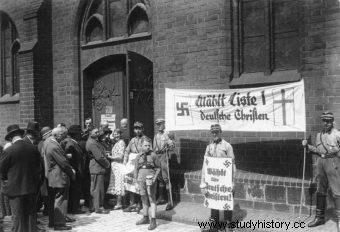
Nazis agitating in front of the church, 1933 (source:Bundesarchiv, Bild 183-1985-0109-502, license:CC-BY-SA 3.0).
Pius was convinced that open opposition would only make matters worse and will harm not only the Catholic Church and Catholics for whom he was directly responsible, but also the victims of German crimes - states Kershaw in the book "To Hell and Back." Europe 1914-1949 ". As he emphasizes, the Pope reasoned similarly about the murdered Poles and Jews.
War "heroes"
Even hundreds of priests and pastors arrested in the Third Reich do not change the fact that the predominant behavior among the tens of thousands of German clergy was passivity. They followed in the footsteps of their superiors, who were often inconsistent and opportunistic.
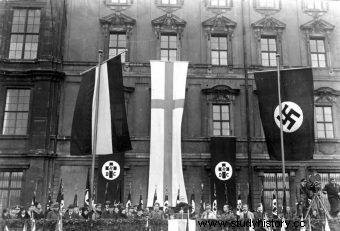
Many clergy, both Lutheran and Catholic, supported the Nazis, but even more were passive priests who did not dare to criticize the Nazi crimes. The photo shows the celebration of Luther Day in Berlin organized by the Nazi-supporting Protestant organization "Deutsche Christen" (source:Bundesarchiv, Bild 102-15234, license:CC-BY-SA 3.0).
Bishop of Osnabrück Wilhelm Berning knew about the plan to murder European Jews as early as February 1942 that is, soon after the meeting of Nazi prominent figures in Wannsee devoted to "the solution of the Jewish question" (as they euphemistically called it). However, he did not have the courage to speak out loudly. And yet he could criticize the Nazi program of euthanasia (the so-called Action T4) - just like the distinguished bishop of Münster Clemens August von Galen.
Even those prelates who more or less secretly criticized the authorities of the Third Reich took part in the pompous Nazi celebrations . In addition, according to at least some historians, Christian anti-Nazi organizations such as the White Rose (established by a group of Munich students, including the Scholl siblings) could not count on the support of the clergy. There were arguments that, according to the teaching of the Church of state authority, one should simply obey!
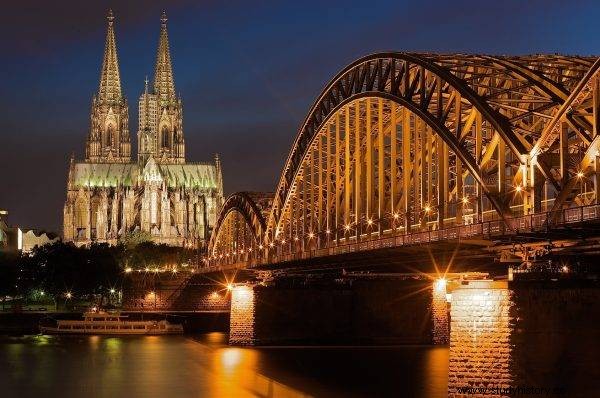
Cologne Cathedral and Hohenzollern bridge
However, all of them were beaten by the aforementioned bishop Alois Hudal, who organized a network in Rome to help the Nazis fleeing the continent after losing the war. He stated that he was worried about the fate of these "heroes defending Europe against Bolshevism." Why did the Vatican tolerate his attitude?
Perhaps because Pius XII himself trembled more at communism than at Nazism? As a result the network in which Hudal operated managed to provide shelter to such "heroes" as Josef Mengele, Adolf Eichmann , Klaus Barbie, Erich Priebke, Alois Brunner or Franz Stangl…
